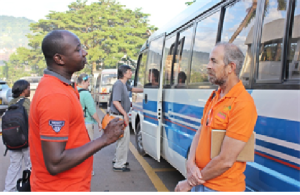“I did not find sweetpotato, sweetpotato found me,” says Solomon Afuape, the Head of Sweetpotato Breeding Program at the National Roots Crops Research Institute (NRCRI), located in Umudike, Southeast Nigeria. When he was employed in 2002, he was deployed to the Sweetpotato Commodity Crop Programme. He knew nothing about sweetpotato. “I had never even seen the sweetpotato crop before I went to Umudike, I had only seen the root,” he recalls.
Things have changed tremendously since then. Afuape started with the basics, learning the basic biology of sweetpotato and how to handle it, and finally, starting to breed in 2003. He did his first crossing in 2004. It was an open pollinated crossing on a small scale. Since then, he has developed into an experienced sweetpotato breeder.
Learning from the community of breeders
Afuape credits a lot of his professional growth to the community of sweetpotato breeders in sub-Saharan Africa. He attended the first annual sweetpotato breeders’ meeting in 2006. At the time, it was hosted by International Potato Center’s Vitaa Initiative. Since then, Solomon says that he has only missed two meetings, once because he was attending his further studies, and the second time, because he could not get a visa to travel to the meeting venue.
Afuape values the lessons he got from members who have bred sweetpotato for a longer time. He has learned the efficiency and effectiveness of breeding and new breeding methodologies. Even more importantly, field visits and practical experiences have influenced his breeding practices. He recalls that when the meeting was held in Uganda for the first time, he got a chance to see how a crossing block looks like. “By then I had been breeding sweetpotato for only three years and I had no real practical experience in managing a crossing block. The visit gave me a good idea about what I should be doing,” he says.
As a budding breeder, Afuape was breeding a few hundred seeds at a time. A meeting focusing on how to handle a large number of clones changed all that. He has scaled up his operations and now handles thousands of seeds. “Had I not heard from those who were handling large numbers of seeds and seedlings, I would have had great challenges,” he reflects.
Experiencing the growth of the Community of Practice
The meetings are held annually, but in Afuape’s eyes, the long period between face-to-face meetings does not diminish the benefits he derives from contact with colleagues. “I make contacts and I can send emails to people when I need help. For example, I just spoke with Jan Kreuze, who is the virologist at International Potato Center in Lima, about phenotyping for Sweetpotato Virus Disease. We plan to continue our discussion by email.”
It’s almost a decade since Afuape attended his first annual breeders’ meeting. Since then, the community has grown and evolved. More recently, the Sweetpotato Action for Security and Health in Africa (SASHA) project has been supporting the activities of the sweetpotato support platform. Through the project, efforts were made to breed and develop new sweetpotato varieties, improve existing populations and develop new breeding methods such as the accelerated breeding scheme and promote exchange of information, skills and technologies across sub-regions.
The number and diversity of members has grown steadily and the format of the meeting has changed to reflect this diversity. “Previously, we used to present our progress on an individual basis but it is good that we now discuss breeding according to sub-regions, Afuape comments. The content too, has changed, with the topics attaining a progressive complexity and depth. He partly attributes this to the fact that many more institutions are now involved in organizing and hosting the event. One of the outcomes of these efforts is the addition of the genomics component to the annual meeting. The development and utilisation of genomic tools in breeding offers much promise in addressing the outstanding challenges in breeding for SPVD and weevil resistance.
Although Afuape understands genomics only in theory, his interest has grown, and for his PhD work, he plans to carry out a Quantitative Trait Locus (QTL) analysis of some selected sweetpotato production and consumer traits. He was especially pleased that the genomics team joined the last annual meeting, held in Mukono Uganda at the beginning of May 2015. “I have done a lot of reading on what to do and how to do it, and my thoughts have been confirmed by their presentations. I now know am on the right path,” he says.
The challenge of applying genomic tools to breeding, according to Afuape, is access to sufficient funds. However, he is optimistic that as with the past development in his career as a sweetpotato breeder, he will find a solution through support and exchange of ideas with members of the Community of Practice.